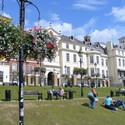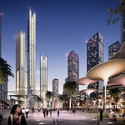There are few mediums that the Grimm Brother's Fairy Tales haven't been adapted into. Bowdlerized stories and films for children have since given way to revisionist tales that embrace the gruesome coloring of the originals, but something about the Grimm Brothers' gothic folklore still holds sway over popular imagination around the world. No matter what kind of adaptation is created - musical, childlike or modernized - the essential Grimmness of the tales still glowers through. FleaFolly's Grimm City is just such a creation.
Articles
FleaFolly's Grimm City: The Antidote to Disney
Opinion: Transparency In Architecture Competitions Is A Bad Thing

What have these three projects got in common? They will never be published in a reputable architecture magazine. This news is no surprise: only a few projects in all the world deserve the right to be published. Editors set trends, put focus on hot topics, give visibility to emerging firms and confirm architectural stars.
A printed magazine has limited space and therefore has to engage in a very strict decision-making process; only the very few are shown. In this Darwinian selection some worthy and brilliant architects perish. On the other hand, an internet site has the possibility to widen the projects range. The web has virtually unlimited space - but still, this space is not to be wasted. Very few would benefit from a site that published every architecture project on earth.
Critical Round-Up: Renzo Piano's Whitney Museum

Depending on how you measure it, Renzo Piano's new building for the Whitney Museum of American Art in New York (designed in collaboration with New York practice Cooper Robertson) could be the most long-awaited museum of the 21st century. At just a fraction under seven years since the first designs of the building were released, the incubation period has been long enough on its own - but in fact the project has its roots in a scrapped 1981 design by Michael Graves, when the Whitney was instead planning an extension to their previous home in Marcel Breuer's 1966 masterpiece on Madison Avenue. With such a highly anticipated building, the Whitney could hardly have a better man for the job; Piano is one of the most prodigious museum builders of our time. Yet despite this, since construction began in 2011 the design has been beset by criticism for its ungainly external appearance.
Ahead of the Whitney's grand opening on May 1st, this past Sunday saw a slew of reviews from New York's many reputable art and architecture critics, who attempted to make sense of the institution's long-overdue move from their idiosyncratic but endearing former home. We've rounded up some of the best of them, after the break.
Lacaton & Vassal's Lesson in Building Modestly

The French duo of Anne Lacaton and Jean-Philippe Vassal are known for their delicate interventions, repurposing neglected structures with apparent effortlessness. Originally published on the Harvard Gazette website entitled "They Build, But Modestly," this article recounts the lessons which they offered students in a recent lecture at the Harvard Graduate School of Design.
Around 1980, two young architects finished their training in Bordeaux, France, and moved to Nigeria. In that African nation’s remote regions, they were inspired by the simple structures they saw amid the stark, stunning desert landscapes. The houses were open to the air, had utilitarian thatched roofs, and were made with bits of local wood. Modesty prevailed in structures that also invited beauty.
The lessons of building in Africa stayed with Anne Lacaton and Jean-Philippe Vassal in their Paris-based practice, Lacaton & Vassal: use what is there, stay simple, embrace open air, and honor light, freedom, and grace. They practice social architecture based on economy, modesty, and the found beauty of environments.
What Is The Role Of Hand Drawing In Today's Architecture?

Update: We have now published our follow-up article of readers' responses - see it here.
6 Classical Buildings That Are Younger Than You Think
.jpg?1429206021)
For the best part of a century, architectural discussion has been dominated by modernism and other related forms of futurism and functionalism. For some, this constant invocation of the radically new has begun to look quite tired. In the 1980s looking backwards for inspiration famously brought us the adaptive and populist postmodernists, but also emerging at this time was New Classical architecture, which completely rejected any continuity with modernism and returned instead to traditional rules. In the years since, New Classical architecture has evolved into a resurgence of pre-modern forms, with the term also incorporating designs that would never have been considered "classical" in the first place - including Gothic and non-western historicist styles. We've rounded up some of the most surprising, interesting - even high-tech - examples of New Classical architecture after the break.
How Subvert Studio Proposes To Revive a Renowned Lisbon Landmark

With Lisbon now bouncing back from the 2008 recession, its estimated 12,000 buildings in decay offer plenty of opportunities to bring the city's buildings more in line with its new economic structure. In this article, originally published by Curbed as "What Could Be Next for a Noted Lisbon Modernist Relic?" Lisbon's Subvert Studio presents a speculative proposal for one of the city's most notable - and visible - modernist ruins.
Views from the balcony of what was once the Panoramic Restaurant of Monsanto show a band of green treetops, a stretch of white cityscape that spans Lisbon's old and new quarters, and a glimmering slice of the Tagus river beyond, mouthing toward the Atlantic. Bracketing the view is blue: a blue sky above, and below, a blue smash of broken glass, reflecting and refracting the sky's color. Wherever there is a vista at the Panoramic Restaurant of Monsanto, wherever there are windows—and the view is the focal point of the space—there is broken glass.
Last used as a club at the top of a 2,400-acre city park, the modernist structure has slipped ever further into riotous abandon since the mid-1990s. Windows have collapsed, graffiti long ago joined the reliefs by Portuguese ceramic muralist Querubim Lapa on the walls and the stained glass sculpture at the entry, chunks of ceiling have tumbled to the ground. And in recent months, a discussion has emerged: what to do with this city-owned modernist relic, which some estimate will require 20 million Euros to fix?
Patrik Schumacher Actually Makes a Good Point

Last week Patrik Schumacher, director at Zaha Hadid Architects and the practice's frontman in the field of architectural theory, took once again to Facebook to disseminate his ideas - this time arguing that "the denunciation of architectural icons and stars is superficial and ignorant." In the post, Schumacher lamented the default position of the architectural media which he believes sees success and reputation as "a red cloth and occasion to knock down icons," going on to outline his beliefs on why stars and icons are useful and even inevitable mechanisms of architectural culture.
Schumacher has made headlines via Facebook before, with a post last year in which he argued for an end to the "moralizing political correctness" that has led to the popularity of socially-conscious design - a post which attracted almost universal outrage from architects, critics and social media users of all stripes. However this latest post had a very different feel; many people, myself included, seemed to find themselves at least partially agreeing with Schumacher. After all, at the most basic level he was asking for designs to each be judged on their individual merits - what's not to like?
A Virtual Look Into The Eames Case Study House #8
The Eames Case Study House #8, usually known simply as Eames’ House, is usually presented as a kind of kaleidoscope of details. It remains one of the most exuberantly performative homes in the history of architecture, with its resident designers, Charles and Ray Eames, as the chief actors. They enacted the day-to-day as an ongoing celebration, documenting the daily rituals of work, play, and hospitality with photography and film. What this theatre of life conceals is that the Eames’ house was itself, structurally, a kind of theatre. Examining the house as an interactive Archilogic 3D model holds, for this reason, some revelations even for those for whom the house looks as familiar as an old friend.
AR Issues: Architecture That Goes Beyond Style Wars

ArchDaily is continuing our partnership with The Architectural Review, bringing you short introductions to the themes of the magazine’s monthly editions. In this editorial from AR’s March 2015 issue, AR Editor Catherine Slessor discusses the phenomenon of "architects and magazines pursuing content rather than style," arguing both that architects should be raising the bar and also that the media, by nurturing their critical stance, should be a part of the solution, not the problem.
In what style shall we – or indeed, should we – build? Historically, architecture’s relationship with "style" is complicated and vexed. We can easily identify the formal attributes and origins of specific styles that attest to why Gothic cathedrals or Victorian train sheds look the way they do. But beyond the constraints of such historical determinism, Postmodernist and Parametricist multiplicities have allowed a hundred flowers to bloom, and their aroma began to stink the place out long ago.

10 Things The “Cities: Skylines” Video Game Taught Us About Modern Urbanism

Ask a random person in the street about their favorite hobbies, and it’s unlikely that they’ll say “urban planning and traffic management” - yet when video games began to take off in the late 1980s city-building was one of the first breakout hits, in the form of Maxis’ SimCity series. The huge success of the “Sim” series in general drove conversations about the value of simulation, as part of the general 1990s optimism about virtual worlds being the future. Sim games became the subject of academic critiques of their philosophy of the world, while city builders became a lot more than a game: in 2002, SimCity 3000 was used as a semi-serious test for mayoral candidates in Warsaw.
After a slump caused by a difficult transition to 3D graphics, city builders are back in vogue. Following what is widely considered as a disappointing SimCity reboot in 2013, Finland’s Colossal Order recently released Cities: Skylines to critical and financial success. But simulations require assumptions; they are, after all, written by people who have their own conscious and unconscious views on how and why cities work. The limitations around designing a video game - the fact that each asset must be modeled and textured, and that each transport option requires a huge amount of work to simulate - mean that Cities: Skylines is as stripped down and streamlined an articulation of urban philosophy as Le Corbusier’s Ville Radieuse or the New Urbanists' models, and just as interesting. We investigate 10 things this game tells us about 21st century urbanism, after the break.
Are Computers Bad for Architecture?

In his articles for ArchSmarter, Michael Kilkelly often praises the value of computers and automation, a sometimes controversial viewpoint with plenty of supporters on either side. In particular, his previous post on ArchDaily, "5 Reasons Architects Should Learn to Code" provoked a significant discussion. But what is the value of this automation? In this post originally published on ArchSmarter, he expands on his view of what computers can be useful for - and more importantly, what they can't.
I write a lot about digital technology and automation here on ArchSmarter, but deep down inside, I have a soft spot for all things analog. I still build physical models. I carry a Moleskine notebook with me everywhere. I also recently bought a Crosley record player.
I can listen to any kind of music I want through Spotify. The music world is literally at my finger tips. Playing records hasn’t changed what I listen to but it has changed how I listen to music. There’s more friction involved with records. I have to physically own the record and I have to manually put it on the turntable. It’s a deliberate act that requires a lot more effort than just selecting a playlist on Spotify. And it’s a lot more fun.

Architecture, Economics and Aquariums: Can ICM Revive the Bilbao Effect in Asia?

The "Bilbao effect" was once viewed as the savior of the other cities; a way for post-industrial cities in the 1990s and 2000s to not only replace their economic reliance on failing industry with tourism, but to reinvent themselves as capitals of High Culture, enriching both body and soul. This has long since ceased to be the case, and many now see it instead as an ironic monument to hubris. But while architecture in the west is attempting to find a viable successor, rapidly expanding economies in Asia and South East Asia seem poised to embark on a new wave of architectural and cultural flourishes designed to attract tourists and Thai Baht.
Hand vs. Computer Drawing: A Student's Opinion

In the debate about how architects - both present and future - represent our ideas, it is easy to find a lot of articles supporting both sides. One can read as many arguments as they want and find valid points supporting both hand-drawing and computer production. One could argue that there is nothing prettier than a well done hand-rendering of a project. Another could say that, although hand-drawing is something that catches the eye, it is not practical at all, takes longer than doing it on the computer and does not allow architects to easily modify it.
There is however another facet that does not come up as frequently as it maybe should: how does this discussion affect students? I believe we lie in a cross-fire, between the idea of what architects do and what they actually do.
Light Matters: Learning From Vernacular Windows

Before computer daylight simulations were used to optimize the atmosphere and energy in buildings, generations of builders developed simple principles to create the best windows for their site. Two lighting experts have studied these traditional openings in buildings to find inspiration for more sustainable designs today. Francesco Anselmo, a lighting designer at Arup, and John Mardaljevic, Professor of Building Daylight Modelling at the School of Civil & Building Engineering of Loughborough University, have analysed the sun and skylight variations from northern regions like Stockholm down to the equator in cities like Haiti or Abu Dhabi.
Read on to learn more about the variety of traditional windows.
For and Against All-Nighter Culture: ArchDaily Readers Respond

Nearly three weeks ago, the editors at ArchDaily reached out to our readers to help us investigate one of the most difficult challenges of architecture education: what do students and teachers think of the 24-hour studio culture that has come to pervade the architecture profession? As we mentioned in our original post, the idea that all-nighters are simply an unavoidable part of an education in architecture has come under fire recently, with some schools attempting to combat them by closing their studios overnight. Is this the right approach to reducing the hours that students are (over)working? If not, what should be done instead? Perhaps there are some people that still think a 24-hour culture can be beneficial to young architects?
The response we got to our question was astonishing, with 141 comments on the article itself and over 100 more on our Facebook post. From this discussion, two overriding themes emerged: firstly, many commenters seemed to believe that architecture students have too much work in the first place; secondly, there was almost complete consensus that closing the studios achieves nothing but moving the problem of all-nighters from the studio to students' homes. For the sake of brevity we've chosen not to include the many responses that mention these themes ideas in this post, but for anyone interested in seeing the evidence of these opinions, we encourage you to visit the original article.
As for the remainder of the comments, we've rounded up some of the most interesting contributions. Find out what 15 commenters had to say about the 24-hour studio culture - taking in arguments for and against it as well as discussing its wider consequences and ways to avoid it - after the break.
Virtual Reality: Coming to an Architecture Office Near You

Virtual Reality. It’s an old term, even an old technology, but it carries new weight - and it’s coming to architecture, soon. Its prevalence will be a result of its near universal accessibility; the experience can now be powered by the modern cell phone. It’s probably on your desk, in your pocket - you may even be reading on a virtual reality engine right now. The price point to participate, thanks to Google Cardboard and a device you already own, is less than twenty dollars.
Google Cardboard might be considered a wearable, but don’t think Google Glass and shiver. As it stands, the technology is more inline with a smart-tv or peripheral, not something to be worn in public. Before we get into what it is, let’s talk about what it can do. We as designers have gotten very good at showing what a space might look like, but in many ways we have come no further in demonstrating what a space feels like.
Mateusz Pospiech Proposes a Megastructure to Replace Iran's Dried Up Zayanderud River

For generations, nature has been held up as something to respect, to take inspiration from, to place at the center of architecture. Few new designs today are complete without some visualized parkland or tree placed implausibly high up on the latest visionary high rise development. But what do you do when nature ups and leaves? How can architecture respond? That’s the question that Mateusz Pospiech’s master’s thesis, completed at the Silesian University of Technology, attempts to answer by taking the severe example of the disappearance of Iran’s Zayanderud River and proposing the equally incredible solution: an enormous, six-kilometer-long ecologically sustainable megastructure along the dried riverbed, healing the scar both in the landscape and in the minds of Iranians.
Unified Architectural Theory: Chapter 9B

We will be publishing Nikos Salingaros’ book, Unified Architectural Theory, in a series of installments, making it digitally, freely available for students and architects around the world. In the following chapter, Salingaros continues his discussion of Christopher Alexander's “Mirror of the Self” test introduced in Chapter 9A, and revealing how it can be used to provide all-important feedback to enable evidence-based design. If you missed them, make sure to read the previous installments here.
Evidence-based design is now fast becoming a standard tool used in school design. (See Peter C. Lippman: “Evidence-Based Design of Elementary and Secondary Schools”, 2010). And yet its current application, while laudable, is missing the other key components necessary for adaptive design: Biophilia, Intelligence in the environment (two topics discussed in this book), and Pattern Language. All of these have to work together to give optimal design results.
Evidence-based design permits an architect to evaluate a design, and variations of that design, to see if they contribute to human wellbeing. This makes possible informed choices that push and guide a design towards a more adaptive final form. We know the result is going to be more adaptive since we check each intermediate stage of an evolving design.
Playing with Balance and the Balance of Play: Hello Wood's 2014 Camp

A shortened version of this article by ArchDaily's Managing Editor Rory Stott appears in HW 1-5, a book by the organizers of Hello Wood about the camp's first five years.
Arriving at Budapest’s international airport on a warm Saturday in July, I confess to being unprepared for my week ahead at Hello Wood 2014. Hungary was the third country and Budapest the fourth city I had been in in 72 hours, and thanks to this (uncharacteristically) chaotic week, I hadn’t had the chance to research anything about the camp. All I knew was what could be learned from the photos of the 2013 camp which I had published almost a year earlier: that is, that the camp is held in an idyllic rural setting, presumably a significant distance from Budapest; and that the quality of work seems unusually high for a week-long architecture workshop, presumably indicating a serious, focused atmosphere at the camp.
The first of these assumptions was absolutely right. But the second could hardly be more wrong. In fact the atmosphere at the camp was so far from being serious that by Tuesday, Gábor Betegh - a friend of the organizers and coincidentally Cambridge University’s new Laurence Professor of Ancient Philosophy - told me how fascinating it was to compare the “centripetal madness” of the philosophers he knows to the “very centrifugal madness” of the architects at the camp. This remark was made in response to one of the team leaders screeching like a monkey from the top of his team’s half-completed tower.
8 Influential Art Deco Skyscrapers by Ralph Thomas Walker

No architect played a greater role in shaping the twentieth century Manhattan skyline than Ralph Thomas Walker, winner of the 1957 AIA Centennial Gold Medal and a man once dubbed “Architect of the Century” by the New York Times. [1] But a late-career ethics scandal involving allegations of stolen contracts by a member of his firm precipitated his retreat from the architecture establishment and his descent into relative obscurity. Only recently has his prolific career been popularly reexamined, spurred by a new monograph and a high-profile exhibit of his work at the eponymous Walker Tower in New York in 2012.
Review: 'All Of This Belongs To You' - Civic Urbanism At London's Victoria & Albert Museum

The Victoria and Albert Museum (V&A), named after the Queen and Her Consort, has its foundations in the Great Exhibition of 1851 amidst the wealth, innovation and squalor of the Industrial Revolution. Britain was flooded by prosperity which allowed for the development of major new institutions to collect and exhibit objects of cultural significance or artistic value. The institute’s first director, Henry Cole, declared that it should be “a schoolroom for everyone,” and a democratic approach to its relationship with public life has remained the cornerstone of the V&A. Not only has it always been free of charge but it was also the first to open late hours (made possible by gas lighting), allowing a more comprehensive demographic of visitor.
Their latest exhibition, which opens today, seeks to realign the museum’s vast collection and palatial exhibition spaces in South Kensington with these founding concepts. The interventions of All of This Belongs to You attempt to push the V&A’s position as an extension of London’s civic and cultural built environment to the fore, testing the museum’s ability to act as a 21st century public institution. To do this in London, a city where the notion of public and private is increasingly blurred, has resulted in a sequence of compelling installations which are tied together through their relevance either in subject matter, technique, or topicality.
6 Politically Motivated Cities Built From Scratch

Threatening to end Cairo’s 1,046 year dominance as the country’s capital, earlier this month the government of Egypt announced their intentions to create a new, yet-to-be-named capital city just east of New Cairo. The promise of the more than 270 square mile ‘new New Cairo’ has attracted headlines from around the world with its sheer scale; a $45 billion development of housing, shopping and landmarks designed to attract tourism from day one, including a theme park larger than Disneyland. And of course, the plans include the promise of homes - for at least 5 million residents in fact, with the vast number of schools, hospitals and religious and community buildings that a modern city requires - making the new capital of Egypt the largest planned city in history.
The idea of building a new capital city has appealed to governments across history; a way to wipe the slate clean, stimulate the economy and lay out your vision of the world in stone, concrete and parkland. Even old Cairo was founded as a purpose built capital, although admittedly urban planning has changed a little since then. It continues to change today; see the full list of different ways to build a totally new city after the break.
5 Reasons Architects Should Learn to Code

In his popular post on how architects can "work smarter, not harder," Michael Kilkelly suggests that you should "customize your tools to work the way you work" and "use macros to automate repetitive tasks." Both sound very helpful of course, but wouldn't those require you to to write some code? Yes - but according to Kilkelly this should be a tool available in every architect's toolkit. Originally published on ArchSmarter, here he offers 5 reasons that architects should learn to code.
As architects, we need to know a lot of stuff. We need to know building codes, structures, mechanical systems, materials. We need to know how to read zoning codes, how to calculate building area, how to layout office floor. The list goes on and on. Do we really need to know how to write computer programs as well?

















.jpg?1429206001)






























